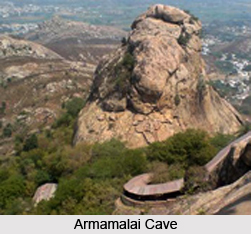 The Armamalai Cave, which is basically a temple of the Jain religion, is adorned with paintings of the ancient period. The Armamalai Cave, located in Tamil Nadu, became renowned during the late 1960s and was discovered western researchers during that period. The temple depicts stories of the Jain religion through stunning paintings that have managed to survive till the recent times. The natural caves of the Armamalai were made into a Jain religious temple during the 8th century AD.
The Armamalai Cave, which is basically a temple of the Jain religion, is adorned with paintings of the ancient period. The Armamalai Cave, located in Tamil Nadu, became renowned during the late 1960s and was discovered western researchers during that period. The temple depicts stories of the Jain religion through stunning paintings that have managed to survive till the recent times. The natural caves of the Armamalai were made into a Jain religious temple during the 8th century AD.
The cave, which is adequately large, has 3 separate segments, where the walls are plastered with bricks made out of a mixture of soil and straw, merged with mud; and has turned into the Trikuta, a complex of 3 shrines. This cave earlier boasted paintings of the technique known as the Northern Technique, which has also been applied in the Bagh Caves. The brick structure was made with a layer of mud, which was then covered with lime and bound by gum obtained from animals. It was rather easy to create delicate colourful works of arts on the light surface plastered with lime.
Although the paintings have not been preserved properly, but this method has also been utilised in other similar construction of that region, as it is evident from its extensive use in south India. This was possible as artists used to travel widely during medieval India that influence local cultures.
Another method, known as the southern technique was also applied in these cave paintings. The preservation of these paintings is comparatively better. The outer surface of the walls and ceiling are covered with paintings that depict stories of Jainism. The western area of the ceiling is covered with deigns of floral pattern, with lotus being the dominating theme. There are also paintings that indicate a female figure along with other people.
The cave has a south facing entrance and the floor consists of deposits from the Iron Age, in the valley located below materials related to rituals of burials are also found. Inside the cave, some remnants were also found in the debris, which are fragments of sculptures, Dvarapalas, and adequate details of lotus carving with inscription in Tamil language are found as well. Armamalai Cave is extremely valuable and as well as a delicate monument of artistic expression and history.



















